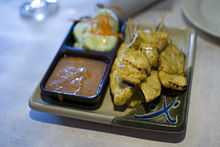Peanut sauce
| Peanut sauce | |||||||||||||
 Chicken satay served with peanut sauce | |||||||||||||
| Simplified Chinese | 沙爹酱 | ||||||||||||
|---|---|---|---|---|---|---|---|---|---|---|---|---|---|
| Traditional Chinese | 沙爹醬 | ||||||||||||
| |||||||||||||
Peanut sauce, satay sauce, bumbu kacang, sambal kacang, or pecel is a sauce widely used in the cuisines of Indonesia, Malaysia, Thailand, Vietnam, China and Africa. It is also used, to a lesser extent, in European (particularly Dutch) and Middle Eastern cuisine.
Ingredients
The main ingredient is ground roasted peanuts, for which peanut butter can act as a substitute. Several different recipes for making peanut sauces exist, resulting in a variety of flavours. A typical recipe usually contains ground roasted peanuts or peanut butter (smooth or crunchy), coconut milk, soy sauce, galangal, garlic, and spices (such as coriander seed, cumin, etc.). Other possible ingredients are chili peppers, sugar, milk, fried onion, and lemon grass.
Regional


One of the main characteristics of Indonesian cuisine is the wide applications of bumbu kacang (peanut sauce) in many Indonesian signature dishes such as satay, gado-gado, karedok, ketoprak, and pecel. It is usually added to main ingredients (meat or vegetable) to add taste, used as dipping sauce such as sambal kacang (a mixture of ground chilli and fried peanuts) for otak-otak or ketan or as a dressing on vegetables.[1] Introduced from Mexico by Portuguese and Spanish merchants in the 16th century, peanuts found a place within Indonesian cuisine as a popular sauce. Peanuts thrived in the tropical environment of Southeast Asia, and today, they can be found roasted and chopped finely, topping a variety of dishes and in marinades and dipping sauces. Peanut sauce reached its sophistication in Indonesia, with the delicate balance of taste acquired from various ingredients according to each recipe of peanut sauce; fried peanuts, gula jawa (palm sugar), garlic, shallot, ginger, tamarind, lemon juice, lemongrass, salt, chilli, pepper, sweet soy sauce, ground together and mixed with water to acquire right texture. The secret to good peanut sauce is "not too thick and not too watery." Indonesian peanut sauce tends to be less sweet than the Thai one (which is a hybrid adaptation). Gado-gado is eaten with peanut sauce throughout Indonesia showcasing the delicate balance of sweet, spicy and sour.
In Chinese cooking, the sauce is often used on grilled meat. Other uses include hot pot and Dan dan noodles.
Through its former possessions in South East Asia, peanut sauce has become a common side dish in the Netherlands. Besides being used in certain traditional Indonesian and Dutch-Indonesian dishes, it has found its way in to a purely Dutch context when it is eaten during, for instance, a (non Asian style) barbecue or with French fries. A popular combination at Dutch fast food outlets is French fries with mayonnaise and peanut sauce (often with raw chopped onions), called a "Patat Oorlog" (lit. "French fries War"). Peanut sauce is also eaten with baguette, bread, cucumber or potatoes. It is also used as an ingredient in the deep-fried snack food called "Satékroket", a croquette made with a flour-thickened ragout based on Indonesian satay.
In Singapore, peanut sauce is not only used as dipping sauce for satay. It is also eaten with rice vermicelli known as Satay bee hoon.
In Vietnam, it is called tương đậu phộng and is used in cuốn diếp dish.
Commercial versions of the usually home made sauce are available in a number of countries. In Australia, common brands include Fountain and Ayam.[2][3] In the United States, common brands include House of Tsang, Annie Chun's, and Sajen.[4]
See also
References
External links
| Wikimedia Commons has media related to Peanut sauce. |